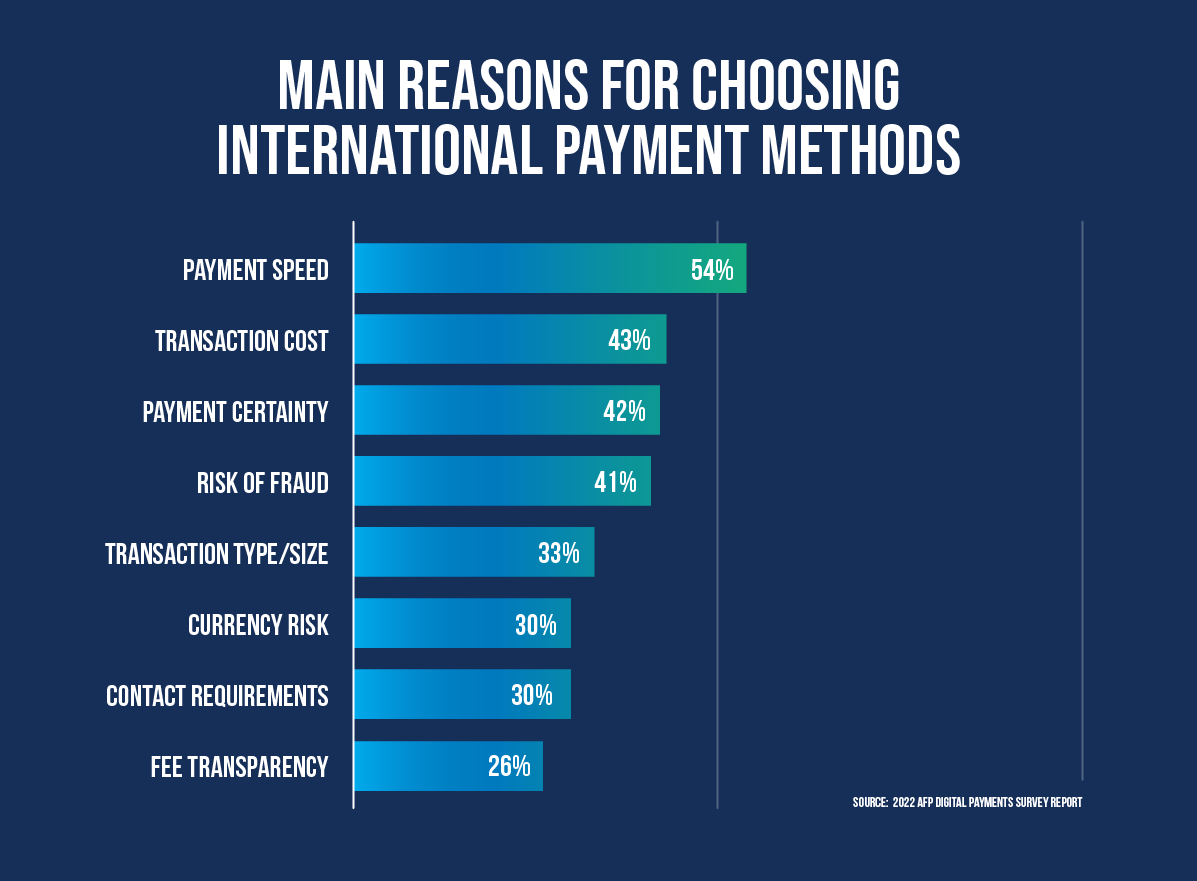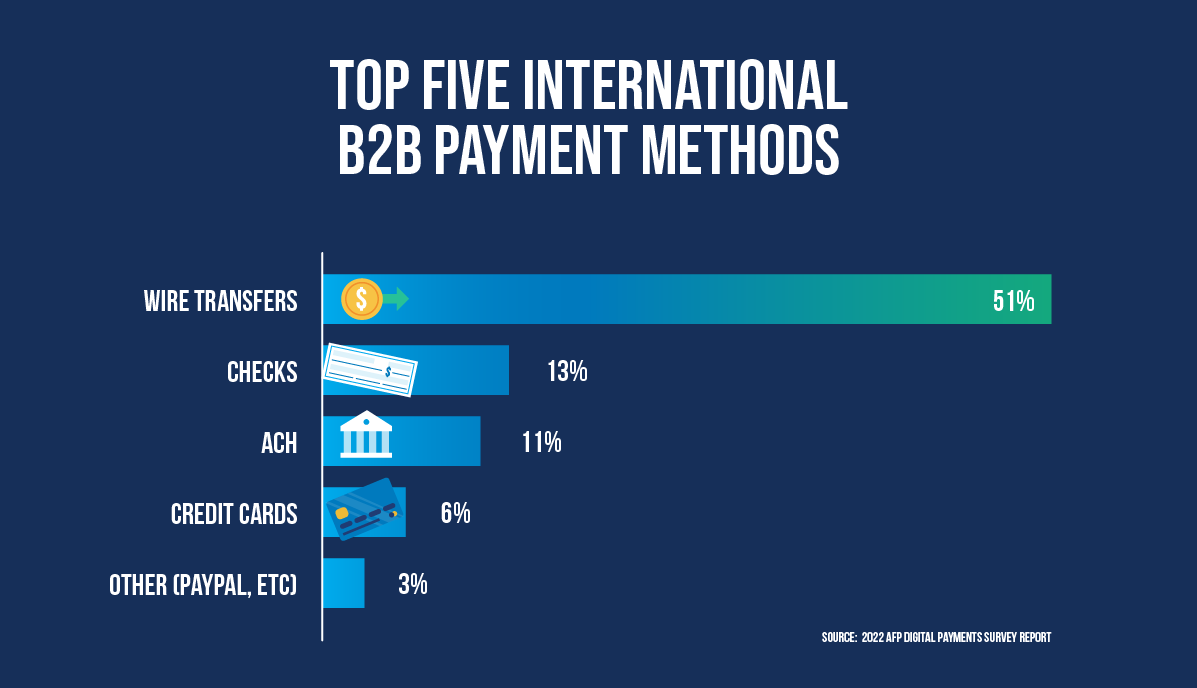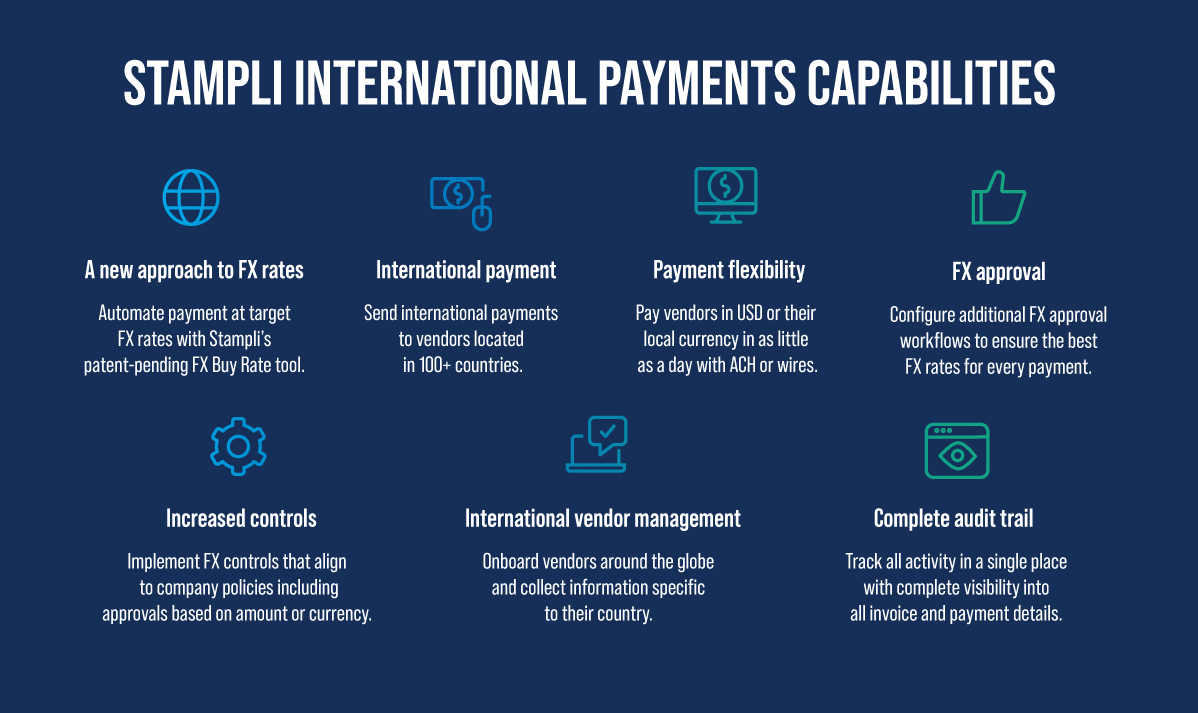Paying International Vendors: The Ultimate Guide

At some point every growing business must deal with international suppliers, which means they must also navigate the world of international payments. Paying international vendors can seem complicated and risky, but with the right understanding and approach it’s no different from any other business challenge.
Read on to learn more about how overseas payments work, the risks and challenges involved, the types of international payment methods, and how you can choose the payment strategy that suits your business best.
What are international payments?
International payments are any type of financial transaction between organizations in two or more different countries. A simple example is international trade—Company A in the USA imports a product from Company B in Canada, Company B invoices them, and Company A pays the invoice.
Actual international payments are more complex than this simple example, but at the root they usually represent a buy/sell transaction across borders. To further explore the nuances and challenges of international payments, we’re going to create a scenario using a fictional business.
I’m the controller of Idealist, an IT consulting company in Maine. We started our business providing management and strategic consulting to IT startups across the US, and have expanded into Canada and Europe. As we’ve grown, we’ve engaged freelancers, agencies, and other suppliers in foreign markets. With this growth in international business has come additional business risks such as foreign exchange exposure, fraud, payment speed, and transaction costs. We’re looking for a solution that lets us optimize our international payments processes and reduce these risks.
Let’s start by talking about our current challenges with international payments.
Challenges of paying foreign vendors
When we began working with international suppliers, we mostly worked with vendors in Canada. Because the Canadian and US banking systems are closely integrated, paying vendors wasn’t much of a problem. Our local bank gave us plenty of options to pay vendors, like wire transfers, ACH payments, credit cards, and paper checks. It was easy for us to create, send, and track payments in our ERP.
Now that we’re dealing with suppliers around the world, our situation is more complex. We face several new challenges paying international suppliers.
Speed of payment
We like to pay our suppliers on time. Doing so lets us avoid late payment fees, and it’s also good for vendor relationships. When we started paying international suppliers, our days payable outstanding (DPO) increased. There are many reasons this is happening. For example, our internal process for approving and processing international invoices in different currencies is slow, errors in our vendors’ banking and payment information cause payment delays, and we need to take time to understand the different international bank requirements for transfers. We’d welcome any improvement in how fast we can complete payments.

Transaction costs
International payments can be expensive. Very often we face high fees for wire transfers and other transactions. We’d like to reduce these costs as much as possible. Cross-border payments are also plagued with high and unpredictable fees that can sometimes exceed the agreed-upon total cost, potentially creating friction between business partners. Other factors that complicate cross-border business include currency risk which could be significant depending on world events—something outside the control of financial professionals. Most businesses hedge their foreign currency exposure, but that adds another variable to the transaction. As for all payments, there is also the risk of fraud—a major concern when transacting internationally.
Certainty of payment
Vendors like to get paid. Unfortunately, with international payments there’s always a risk a payment or money transfer may not go through. Incorrect banking information causes many of the problems–even a slight error in a vendor’s banking info can cause an international bank to reject or misdirect a wire transfer.
Fraud
Fraud is an ever-present risk to our business, especially with international transactions. To be honest, we only have a general idea of how much we might lose to wire fraud. We’re actively looking for solutions to reduce our exposure to fraudulent activity.
Vendor management
It’s important to have accurate and up-to-date vendor information when making international payments. Having the correct financial institution information, vendor name and address, and contact info reduces the risk of delayed or incomplete payments and our exposure to fraud. Currently, we manage our vendor information in a spreadsheet but we’d like to move to an automated and advanced vendor management document system.
Foreign exchange risk
Foreign exchange (FX) rates are changing all the time. We face significant exposure to currency fluctuations when paying international vendors and calculating foreign pricing. For example, say we want to pay a vendor in the UK in British Pounds Sterling. When we create the payment in our accounting system, the US dollar is trading at $1 = £0.79 (or £1 = $1.27). Since the invoice is for £1000, we enter $1270 in our accounting software. However, before we issue the payment, the pound increases to $1.32 USD, which means we actually pay the vendor $1320. We don’t currently have a process in place to mitigate these costs, so as the value of our international transactions increases, we’ll face increasing exposure to changes in foreign exchange rates. Since many of our vendors want to be paid in their local currency, I need to find a solution that lets us control FX exposure as much as possible.
Integration with business systems
Our accounts payable team uses a variety of different methods to pay international vendors. Many of these, such as wire transfers, are manual. As the volume of payments increases, so does the time we spend managing them. Ideally I’d like an automated payment solution that unifies all our payment methods and integrates with our ERP. We currently use Sage Intacct, so ideally we’d like a payment solution that requires minimal changes to our existing system.
With these challenges in mind, let’s move on to look at the payment methods we’re currently using or considering using in the future.
Types of international payments

Here are the most common types of payments we use to pay overseas vendors today, along with a couple of methods we’re considering using.
International wire transfers
International bank wire transfers are the tried-and-true international payment method. They’re fast, secure, and let us pay vendors in almost any country. A wire transfer is a direct transfer from our bank account to our vendor’s bank account. Organizations send most wire transfers today via the SWIFT system, a secure international bank messaging system that lets banks share information about wire transfers.
We use wire transfers because they let us pay vendors quickly and securely, with most vendors getting their funds on the same day or within three business days. However, wire transfers are expensive, with a transaction fee for both us and our vendors. Also, they can leave us exposed to FX risk, as we’re left paying our bank’s foreign exchange rate (and potential extra fees) for each transaction. Finally, wire transfers are difficult to reverse, and if a payment fails, the process of investigating and resubmitting a payment can be expensive.
Checks
We still use paper checks to pay some international suppliers. This is a holdover from the days when we only had suppliers in Canada, where the banks readily accept checks drawn on US-based banks. We still use checks to pay some suppliers in countries where US checks are accepted. Checks are relatively inexpensive compared to wire transfers, and because they’re denominated in US funds, we don’t face any foreign exchange risk.
That said, checks come with risks. First, they’re very slow and they can be lost or intercepted in the mail. It can be almost impossible to track the location of a check once it has been mailed, so this exposes us (and our vendors) to risk of fraud. Also, many international banks place a hold on cashing checks drawn on foreign entities, so our vendors may face significant delays getting paid.
Global ACH
Global ACH, or International ACH, is a service based on the automated clearing house system in the US. It provides fund transfer capabilities using the US ACH system and similar electronic funds transfer systems in other countries, such as the Automated Clearing Settlement System (ACSS) in Canada. Global ACH is cheaper than a wire transfer and offers a similar level of security. However, Global ACH payments are slower, and not every country accepts them.
The National Automated Clearing House Network (NACHA) manages global ACH transfers, so the same rules apply as for domestic ACH transfers. We need to provide identifying data for ourselves and our vendors, such as ACH country codes, bank information, account numbers, routing numbers, and any other information required by both banks involved.
Where possible, we use Global ACH as an alternative to wire transfers because of the cost savings. However, manually entering and updating the vendor information in our accounting software is challenging. As I mentioned, we’re looking for a way to automate our document management to make this process easier.
Foreign currency or overseas bank account
We’re investigating opening and using bank accounts to reduce our transaction costs and foreign exchange risk for international payments. There are two approaches we can take, each with its own advantages and disadvantages.
First, we can open a domestic foreign currency account with our bank in the US or with a US branch of a foreign bank. This account (also known as a borderless bank account) lets us hold, send, and receive money in a foreign currency. We can use a borderless account to reduce our FX risk by funding the account when the FX rate is favorable, and then paying our international vendors in their own currency by wire transfer or Global ACH. For example, we can open a UK pound sterling account here in Maine with the US branch of a UK bank, and fund it with UK pounds when the USD/GBP rate is favorable.
Another option is to open an overseas bank account in another country. Using an overseas account also allows us to manage foreign exchange risk, plus it allows us to pay our suppliers locally, which means we can pay them quickly. For example, we maintain a Canadian dollar bank account in Canada to pay our suppliers based there. We fund the account through our US bank account when the USD/CAD rate is favorable, and pay our Canadian vendors via EFT transfers.
Using a borderless or overseas bank account has a clear advantage to reduce FX risk, however we have some reservations about using them to pay vendors. First, these accounts force us to tie money up because we need to fund them when the FX rate is favorable. We’d need to be careful to balance how much money we need in the account with our current and future cash flow needs–there’s no point saving money on FX rates when we need to borrow money to cover domestic expenses.
Second, banks only denominate these accounts in major currencies, so we’d still need a solution to cover FX risk in other currencies.
Finally, opening an overseas account can be a complex process and it may involve tax and legal implications. For example, when we opened our Canadian account, we needed to check into Canada/US tax treaties to see if there were any specific IRS reporting requirements. (Pro tip: there are)
Peer-to-peer and electronic wallet services
Digital payment providers like PayPal, Venmo, and Bill provide international transfer and payment services. Depending on the type of transaction, peer-to-peer (P2P) payments can be made quickly. When we pay an international vendor, the P2P service would draw funds from our business account, transfer the funds to an account with the P2P service, and then transfer the funds to our vendor. If the vendor also has an account with the P2P service, they transfer the funds to it. If they don’t have an account, the P2P service transfers the funds via wire transfer or Global ACH or another method.
Transfer times through P2P services vary from almost instantly if the vendor has an account with the service provider to several days in case of a wire transfer. P2P transfers can be very expensive. For example, PayPal charges a percentage fee on top of their domestic transfer fee to receive an international transfer, along with other potential fees. These fees are problematic for us because we don’t want to download costs to our vendors. We’re also stuck using the P2P providers’ exchange rates, which may not be favorable to us.
P2P services are easy to use, and often only require the vendor’s email address to complete a payment. However, they require vendors to set up their bank account with the P2P provider, which may be a challenge in countries where this isn’t possible.
Credit cards and virtual cards
The last payment method we’re considering is using corporate credit cards or virtual payment cards to pay international suppliers. Credit cards are fast–often vendors are paid in near real time, they’re secure, and they allow us to track and manage transactions easily. Some cards also offer rewards, which lets us earn a bit of profit while we’re paying vendors.
Many international vendors refuse to accept credit cards, or they may require us to pay the additional merchant fees some card platforms charge for international business payments. Using credit cards also ties us to using the credit card or payment card provider’s exchange rates, which doesn’t help me reduce our FX risk exposure.
That said, credit cards may be an option for certain countries or for vendors who want to be paid quickly and don’t mind paying the merchant fees.
Paying international suppliers: how to get started
Although it may seem like a complicated process, getting started with international payments is relatively easy. Here are some of the key things you need to know:
Decide on your payment methods
Start by choosing the payment options that work best for your business. For example, we need a unified payment automation solution that lets us save money on transactions, manage FX risk, and manage vendor information while integrating with our accounting software and ERP. Assess your current risk and cash flow situation and then look at your existing international vendors and decide on which payment methods work best for you and them.
Gather and manage overseas supplier information
Once you decide on payment options, gather the required banking information and contact details from your vendors. For example, if you choose wire transfers, you’ll need to gather and manage information needed for SWIFT to route the transfer to your supplier’s account. You should also plan to reconfirm and update your vendors’ information regularly to ensure payments aren’t mis-routed or delayed.
Look at tax implications and regulations
International payments can be subject to special tax regulations and reporting requirements by the IRS. For example, for payments to countries that have a tax treaty with the US you may need to complete the appropriate IRS W-8 form (W-8BEN, W-8ECI, W-8EXP, or W-8IMY). You may also be required to issue IRS 1099s or Form 1042-S to vendors. Speak to your tax advisor or accountant to learn how the rules may apply to you.
Choose an integrated payment solution
One of our greatest challenges is that our current manual payment processes are slow and inefficient. Not only does it take us forever to process international payments, many times we also need to manually re-enter the payment information into our ERP. It’s slow, expensive, and leaves us exposed to errors.
We’re looking for an automated payment solution that unifies our international payments into the same workflow as our domestic payments. Ideally, the solution should also manage our vendor documentation and integrate and share data with our ERP. That way, we can streamline our existing processes so our AP team has more time for higher value tasks like reducing our FX risks. Also, by reducing payment errors and processing times we can pay our vendors faster, which like I said is great for vendor relationships and helps us avoid late payment fees.
We looked at a lot of different payment solutions, but Stampli Direct Pay checked all the boxes for us.
International Payments from Stampli Direct Pay
International Payments from Stampli Direct Pay lets you pay international vendors just as easily as domestic vendors. Send international payments with the same workflows and controls as domestic payments—all without leaving your AP system. Pay vendors across 150+ countries while managing internal approval workflows and vendor payment details from within your AP automation system — and save money with a new approach to FX risk.

Pay international vendors fast
Now you can pay international vendors using international wire or international ACH, in USD or local currency, in a matter of days — with some countries eligible for same day payments. As an integrated service from Stampli, you can manage your internal approval workflows and vendor payment details without leaving your AP automation system. All payment records automatically sync back to your ERP while maintaining a complete audit trail in Stampli for easy reconciliation.
Easily manage FX risk
International Payments offers an innovative approach to managing FX risk. Not only do you get much more visibility into FX rates, but Stampli lets you set FX targets for each foreign currency. When target rates are met, Stampli will automatically execute your payments.
Industry-leading payment capability from the leader in AP automation
International Payments eliminates the gap between your AP and payments systems that disrupts your workflows and weakens your control.
Here’s how Stampli’s International Payments gives you control:
- Set target foreign exchange (FX) rates: Stampli tracks real-time FX rates so you can automatically execute foreign currency payments to get the most favorable rates.
- Customizable FX approvals: Configure additional FX approval workflows to ensure the best FX rates for every payment.
- Vendor management: Stampli helps you collect and maintain banking requirements needed for each country to send payments.
- Domestic & international payments from one system: Make all payments from one system and eliminate time-consuming bank processes and portals. Send international payments to vendors located in 100+ countries.
Take the first step towards managing your FX risk. Meet with a Stampli AP expert today.